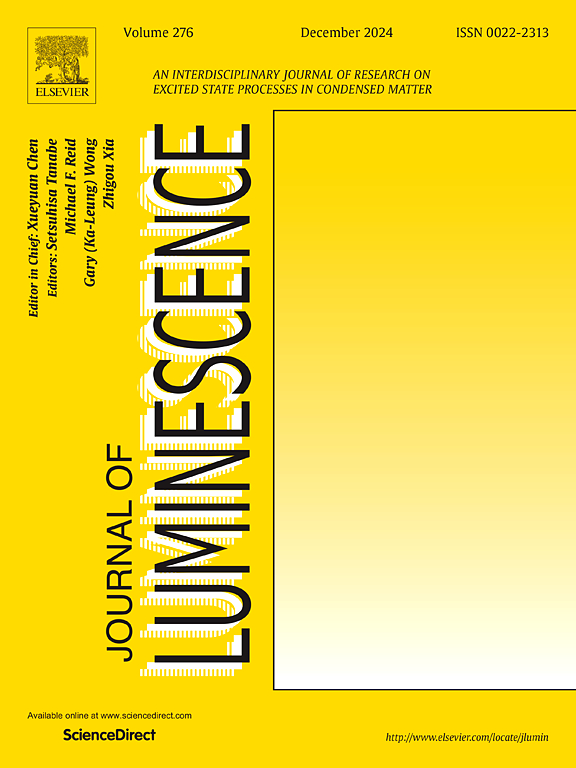掺铒碲酸锌玻璃在可见光和近红外光子应用中的增强光致发光和光学性能
IF 3.3
3区 物理与天体物理
Q2 OPTICS
引用次数: 0
摘要
掺铒碲酸锌玻璃由于其强大的光致发光性能和良好的光学性能,在可见光和近红外(NIR)领域正成为光子应用的重要材料。然而,优化这些玻璃以获得高发射强度,同时避免浓度猝灭仍然是一个挑战。本研究旨在制备和表征具有不同氧化铒(Er2O3)浓度的掺铒碲酸锌玻璃,重点研究其在可见光和近红外区的光致发光行为。采用熔淬法制备了玻璃样品,并通过紫外-可见-近红外光谱和光致发光(PL)光谱对样品进行了分析。结果表明,在绿色(550 nm)区域有较强的发射,在氧化铒的0.02 M分数处发射强度最佳。此外,在1530 nm处观察到宽近红外发射,适合于光通信应用,如宽带光放大器。当浓度超过0.03 M时,由于铒离子间的交叉弛豫机制,浓度猝灭导致强度降低。采用Judd-Ofelt分析和McCumber理论分析了辐射特性和增益系数。研究表明,0.02 M分数是最佳的铒浓度,可以在高可见光和近红外发射强度和最小猝灭之间取得平衡。这些发现证明了掺铒碲酸锌玻璃在改善光通信系统和光子器件方面的潜力,为光纤放大器和激光技术的进步铺平了道路。本文章由计算机程序翻译,如有差异,请以英文原文为准。
Enhanced photoluminescence and optical properties of erbium-doped zinc tellurite glasses for visible and near-infrared photonic applications
Erbium-doped zinc tellurite glasses are emerging as valuable materials for photonic applications, particularly in visible and near-infrared (NIR) regions, due to their strong photoluminescence and favorable optical properties. However, optimizing these glasses for high emission intensity while avoiding concentration quenching remains a challenge. This study aims to fabricate and characterize erbium-doped zinc tellurite glasses with varying erbium oxide (Er2O3) concentrations, focusing on their photoluminescence behavior in both visible and NIR regions. Glass samples were prepared using the melt-quenching method and analyzed through UV–Vis–NIR optical and photoluminescence (PL) spectroscopy. The results showed strong emissions in the green (550 nm) region, with optimal emission intensities at a 0.02 M fraction of erbium oxide. Additionally, broad NIR emissions were observed at 1530 nm, suitable for optical communication applications such as broadband optical amplifiers. Beyond a 0.03 M fraction, the intensity decreased due to concentration quenching, attributed to cross-relaxation mechanisms among erbium ions. Judd-Ofelt analysis and McCumber theory were applied to understand the radiative properties and gain coefficients. The study concludes that 0.02 M fraction is the optimal erbium concentration, offering a balance between high visible and NIR emission intensities and minimal quenching. These findings demonstrate the potential of erbium-doped zinc tellurite glasses for improving optical communication systems and photonic devices, paving the way for advancements in fiber amplifiers and laser technologies.
求助全文
通过发布文献求助,成功后即可免费获取论文全文。
去求助
来源期刊

Journal of Luminescence
物理-光学
CiteScore
6.70
自引率
13.90%
发文量
850
审稿时长
3.8 months
期刊介绍:
The purpose of the Journal of Luminescence is to provide a means of communication between scientists in different disciplines who share a common interest in the electronic excited states of molecular, ionic and covalent systems, whether crystalline, amorphous, or liquid.
We invite original papers and reviews on such subjects as: exciton and polariton dynamics, dynamics of localized excited states, energy and charge transport in ordered and disordered systems, radiative and non-radiative recombination, relaxation processes, vibronic interactions in electronic excited states, photochemistry in condensed systems, excited state resonance, double resonance, spin dynamics, selective excitation spectroscopy, hole burning, coherent processes in excited states, (e.g. coherent optical transients, photon echoes, transient gratings), multiphoton processes, optical bistability, photochromism, and new techniques for the study of excited states. This list is not intended to be exhaustive. Papers in the traditional areas of optical spectroscopy (absorption, MCD, luminescence, Raman scattering) are welcome. Papers on applications (phosphors, scintillators, electro- and cathodo-luminescence, radiography, bioimaging, solar energy, energy conversion, etc.) are also welcome if they present results of scientific, rather than only technological interest. However, papers containing purely theoretical results, not related to phenomena in the excited states, as well as papers using luminescence spectroscopy to perform routine analytical chemistry or biochemistry procedures, are outside the scope of the journal. Some exceptions will be possible at the discretion of the editors.
 求助内容:
求助内容: 应助结果提醒方式:
应助结果提醒方式:


